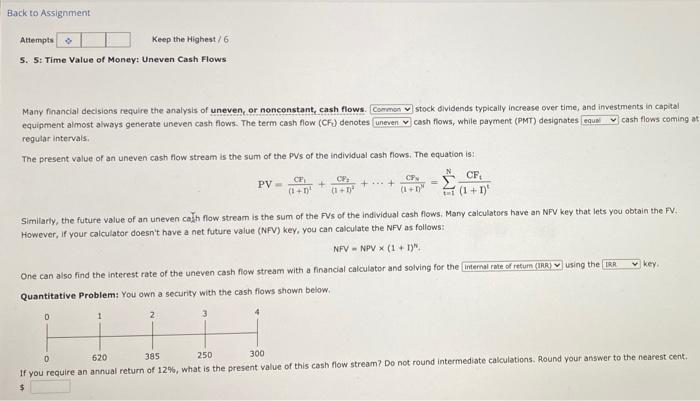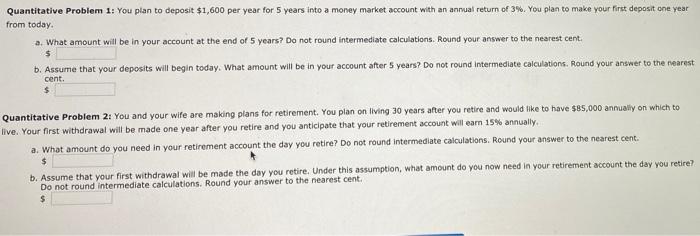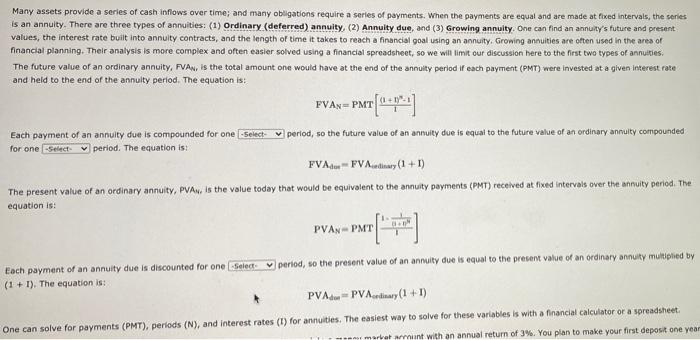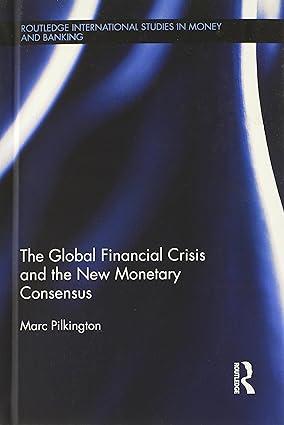Answered step by step
Verified Expert Solution
Question
1 Approved Answer
Please cirlce answers Back to Assignment Attempts Keep the Highest/6 S. S: Time Value of Money: Uneven Cash Flows Many financial decisions require the analysis
Please cirlce answers 


Back to Assignment Attempts Keep the Highest/6 S. S: Time Value of Money: Uneven Cash Flows Many financial decisions require the analysis of uneven, or nonconstant, cash flows. Common stock dividends typically increase over time, and investments in capital equipment almost always generate uneven cash flows. The term cash flow (CF) denotes uneven y cash flows, while payment (PMT) designates que cash flows coming at regular intervals. The present value of an uneven cash flow stream is the sum of the PUs of the individual cash flows. The equation is: PV- + CF CF ++ (1+ (1) 1 (1+1) Similarly, the future value of an uneven calh flow stream is the sum of the FVs of the individual cash flows. Many calculators have an NPV key that lets you obtain the FV. However, if your calculator doesn't have a net future value (NFV) key, you can calculate the NFV as follows: NFV - NPV (1+) One can also find the interest rate of the uneven cash flow stream with a financial calculator and solving for the internal rate of retum (IAR) y using the TRR key Quantitative Problem: You own a security with the cash flows shown below. D 1 2 3 0 620 385 250 300 If you require an annual return of 12%, what is the present value of this cash flow stream? Do not round intermediate calculations. Round your answer to the nearest cent. $ Quantitative Problem 1: You plan to deposit $1,600 per year for 5 years into a money market account with an annual return of 3%. You plan to make your first deposit one year from today. a. What amount will be in your account at the end of 5 years? Do not round Intermediate calculations. Round your answer to the nearest cent. b. Assume that your deposits will begin today. What amount will be in your account after 5 years? Do not round Intermediate calculations. Round your answer to the nearest cent. $ Quantitative Problem 2: You and your wife are making plans for retirement. You plan on living 30 years after you retire and would like to have $85,000 annually on which to live. Your first withdrawal will be made one year after you retire and you anticipate that your retirement account will earn 15% annually. a. What amount do you need in your retirement account the day you retire? Do not round intermediate calculations. Round your answer to the nearest cent. b. Assume that your first withdrawal will be made the day you retire. Under this assumption, what amount do you now need in your retirement account the day you retire? Do not round Intermediate calculations. Round your answer to the nearest cent. $ Many assets provide a series of cash inflows over time; and many obligations require a series of payments. When the payments are equal and are made at fixed intervals, the series is an annuity. There are three types of annuities: (1) Ordinary (deferred) annuity, (2) Annuity due, and (3) Growing annuity. One can find an annuity's future and present values, the interest rate built into annuity contracts, and the length of time it takes to reach a financial goal using an annuity. Growing annuities are often used in the area of financial planning. Their analysis is more complex and often easier solved using a financial spreadsheet, so we will limit our discussion here to the first two types of annuities. The future value of an ordinary annuity, FVA, is the total amount one would have at the end of the annuity period If each payment (PMT) were invested at a given interest rate and held to the end of the annuity period. The equation is: FVAx= PMT(4-14%*) Each payment of an annuity due is compounded for one -Select v period, so the future value of an annuity due is equal to the future value of an ordinary annuity compounded for one Select v period. The equation is FVAFV Audiny (1 +1) The present value of an ordinary annuity, PVA is the value today that would be equivalent to the annuity payments (PMT) received at fixed intervals over the annuity period. The equation is: PVA-PMT Each payment of an annuity due is discounted for one Select period, so the present value of an annuity due is equal to the present value of an ordinary annuity multiplied by (1+1). The equation is: PV APV ordinary (1+1) One can solve for payments (PMT), periods (N), and interest rates (1) for annuities. The easiest way to solve for these variables is with a financial calculator or a spreadsheet market amunt with an annual return of 3%. You plan to make your first deposit one year 


Step by Step Solution
There are 3 Steps involved in it
Step: 1

Get Instant Access to Expert-Tailored Solutions
See step-by-step solutions with expert insights and AI powered tools for academic success
Step: 2

Step: 3

Ace Your Homework with AI
Get the answers you need in no time with our AI-driven, step-by-step assistance
Get Started


